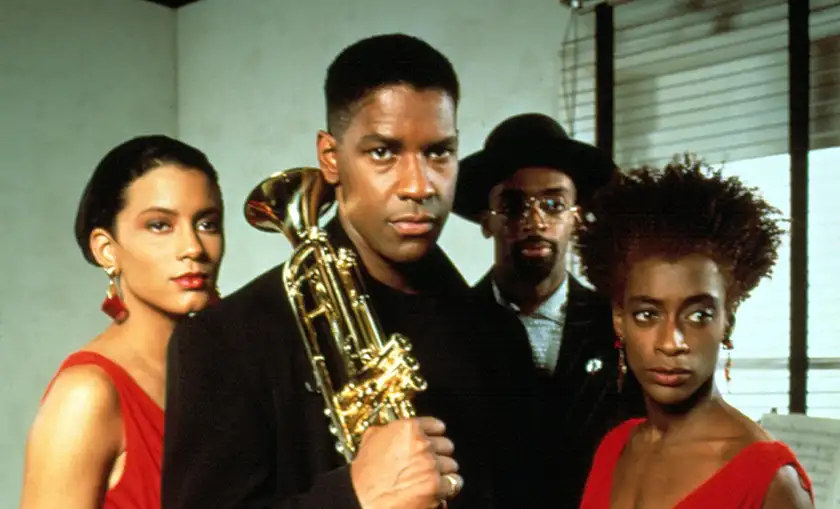Mo’ Better Blues, an atmospheric and stylish Jazz musical, shows Spike Lee searching for his artistic footing after having achieved monumental success.
Writer and Director: Spike Lee
Genre: Drama, Romance, Music, Workplace Drama
Run Time: 130′
US Release: August 3, 1990
UK Release: September 28, 1990
Where to watch: on digital platforms & VOD
Mo’ Better Blues, the fourth feature film directed by Spike Lee, was released 15 months after the world premiere of Do the Right Thing at the Cannes Film Festival. The film was of the most talked about and argued about movies of 1989, and the cultural conversation and critical praise for the piece of work heralded Lee as a brilliant and exciting new filmmaking voice. By the end of the decade it was widely considered a masterpiece and had firmly secured a place among the film canon.
Now, how does an artist follow up The Great American Film like Do the Right Thing? Many filmmakers would be tempted to cash in the recently received blank check, using all of their garnered clout to helm a blockbuster and solidify themselves as a Hollywood power or finally realize their creative ambitions with the deeply personal, esoteric dream project they had never been able to get financed before. Lee’s pace was steadier. For all of its lush production design and complicated, sophisticated camera movements, Mo’ Better Blues is an intimate character study. It’s a movie that feels small next to the angry diagnosis of societal ills in Do the Right Thing. The ideas and concerns in Mo’ Better Blues are personal. Tellingly, considering the period in Lee’s career, this is a movie about creative ambition and obsession, the balance between art and family, and the dangers of show business.
The movie begins with a series of still lifes. Filmed by virtuoso cinematographer Ernest Dickerson, isolated body parts and musical instruments are shot against vivid, hot colors – red, purple, blue, orange. The camera languidly drinks in the shadowy shapes as nocturnal-sounding jazz music plays. After a sensual, melancholy atmosphere has been created the movie proper begins and the audience is introduced to Bleek Gilliam, played with laser-focused eyes and a mischievously crooked smile by Denzel Washington. This is the first of many cinematic collaborations between Lee and Washington, and there is an instinctual understanding of each other’s artistic characteristics and talents.
Mo’ Better Blues shows off all of Washington’s charisma and movie star je ne sais quoi to their highest advantage. The camera seems to swoon whenever he smiles. Bleek is a trumpet player that leads his own band, wailing out jazz tunes alongside Shadow Henderson, (Wesley Snipes) Left Hand Lacey, (Giancarlo Esposito) Bottom Hammer, (Bill Nunn) and Rhythm Jones (Jeff “Tain” Watts). The quintet is managed by Giant, (Lee) whose gambling addiction runs him afoul with the mob and causes no shortage of problems for the group. Bleek is dedicated to his music to the point of obsession, there’s a sneaking suspicion that that’s because he has very little else to fill his life. A girlfriend, the sexy torch singer Clarke (Cynda Williams) observes that he doesn’t actually know what he wants out of life. At the same time as Clarke. Bleak is also seeing Indigo (Joie Lee, the director’s sister), a practical-minded schoolteacher. The crux of the movie is formed by Bleek’s attempts to find personal contentment and a balance between his personal and artistic life.

On the whole, Mo’ Better Blues is rather predictable, hitting plot beats that have been in countless Hollywood movies about artists over the years. Beside’s Bleek, many of the characters are thinly drawn, really too heavily on stereotypes and broad strokes, and the internal psychology behind certain decisions doesn’t always track. Mostly, Mo’ Better Blues is an exercise in style. The script really shines in the dialogue, very witty and wry, with an almost improvisational feeling. This is a movie about sound, not just of music, but of people talking – conversations, fights, stand-up comedy. When the characters talk it’s just as much about the rhythm, lilt and inflection of the words, as it is about the content. The back-stage scenes with Washington, Snipes, Lee, Nunn and Watts,as they tease, laugh and fight, have the energy of a group number in a musical, with counterpoints and harmonies and lines recited in unison.
With the rhythmic dialogue and musical performances by Bleek’s quintet that are used to articulate the emotions and dreams of the characters, Mo’ Better Blues is a musical. It is not hard to imagine the moments in the movie when Bleek, Clarke, Indigo or Giant could possibly burst into song. This sensation is enhanced by the athletic, graceful agility of Dickerson’s camera, moving around the sets like a dancer. The lush, hot color scheme reminded me of the 1961 West Side Story.
In style and content, Mo’ Better Blues hearkens back to classic Old Hollywood, perhaps the ones that Lee would watch growing up. Now that Lee is an established filmmaker he can make those movies himself – move the camera through the denizens of a smoky night club like Michael Curtiz did in Casablanca, or tell the story of a passionate jazz musician torn between two women like Curtiz again did in Young Man with a Horn. Could he do that? With Mo’ Better Blues, Lee, like the movie’s main character, is a man searching for his place in the artistic world.
Mo’ Better Blues is now available to watch on digital and on demand. Read our reviews of 25th Hour, Malcolm X and Da 5 Bloods!
Loud and Clear Reviews has an affiliate partnership with Apple, so we receive a share of the revenue from your purchase or streaming of the films when you click on the button on this page. This won’t affect how much you pay for them and helps us keep the site free for everyone.

